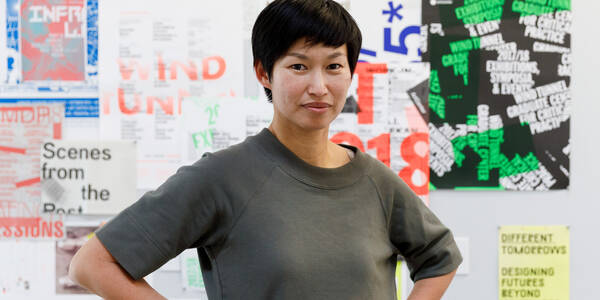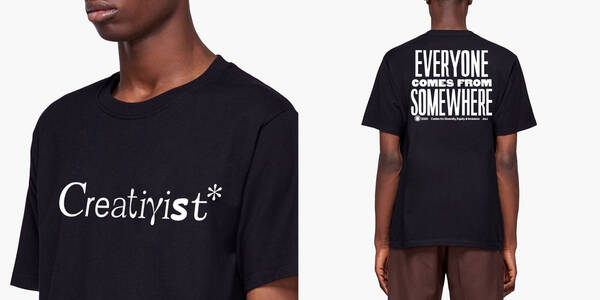
profile / alumni / faculty / designmatters / graphic-design / interaction-design / diversity / spring-2021
April 15, 2021
By Solvej Schou
Images courtesy of Josh Halstead
ALUM AND DESIGNMATTERS FACULTY JOSH HALSTEAD TEACHES ABOUT REIMAGINING ACCESS IN DESIGN
One misconception about accessibility design is that there’s a set checklist to make a logo, commercial or advertisement accessible, says Graphic Design alum and Designmatters and Interaction Design Assistant Professor Josh Halstead (BFA 12).
“Designers want to tick every box, and then they punish themselves when something goes wrong, which it always does,” says the designer and disability rights advocate, whose nonbinary gender pronouns are he/they, via Zoom from their apartment in San Francisco. “The process needs to be more exploratory. The ways in which we understand disability is important to framing questions we ask. Disabilities are fluid, contextual and change over time.”
“If we just think about disability as medical, then we typically strive to have design fix the gaps between bodies and the material world,” they add. “But if we think about disability in a cultural sense, then our designs might also consider fostering connections, which might expand on body and world disconnections. Folks usually think about making content and design accessible, and I enjoy also flipping the paradigm to pose the question, ‘How can access produce content?’”

Folks usually think about making content and design accessible, and I enjoy also flipping the paradigm to pose the question, ‘How can access produce content?’
Josh HalsteadGraphic Design alum
Designmatters and Interaction Design faculty

Born and raised in Rancho Cucamonga to a creative mother and a business owner father, and self-defined as an “uber nerd” and “a disabled kid who was an artist and liked punk music,” Halstead was inspired as an ArtCenter student and later as a teacher by Humanities and Sciences Professor Errol Gerson. “With every lecture, he made me believe I was going to change the world,” says Halstead.
After graduating, Halstead worked for several years at the global branding firm Landor and also volunteered at the Bay Area-based Inneract Project, which empowers underrepresented youth through design education.
After being asked at Landor to give a presentation on inclusive design because of their disability (“I was a little offended,” they say), Halstead soared into the disability design world with more talks and teaching, and went on to earn a master’s degree in Disability Studies from the City University of New York. Senior manager of design since 2019 at the community development financial institution Oportun, Halstead helped design the brand from the ground up, including ensuring its compliance with the American Disabilities Act (ADA). Recently, Halstead brought their love of teaching about accessibility back to ArtCenter.

In Fall 2019, Halstead spent a week on campus as a Designmatters resident. Halstead and their friend, Google Visual Designer Aldis Ozolins (BFA 12 Graphic Design), along with Google Senior Interaction Designer Dru Bramlett, led an accessibility design workshop. Halstead says conducting the workshop was both nerve-wracking and exhilarating.
“There’s almost this panic when you’re back on campus, as an alum, that you have something due,” says Halstead, laughing. After Ozolins did an ice breaker introduction asking students to discuss how they've experienced exclusion, the energy in Halstead’s body changed. “I was tense in my head and shoulders, and then I heard people being vulnerable,” they say. “A student talked about how stools at ArtCenter are terrible for her disability because they hurt her back. She was willing to speak up politically because she had the opportunity to have that conversation. By the time I did my part of the lecture, I looked up at the students, and they were engaged and asking questions.”
In Fall 2020, Halstead joined Designmatters as guest faculty. This Spring 2021 term, Halstead is co-teaching Reimagining Accessibility, a remote Transdisciplinary Studio which is exploring ways to make digital archives more accessible. The studio portion of an ArtCenter Library and Interaction Design project funded by an Institute of Museum and Library Services grant, the course was developed in collaboration with Designmatters. It’s being co-taught by Interaction Design Professors Elise Co and Todd Masilko. Hundreds of people signed up for the project’s Reimagining Access: Inclusive Technology Design for Archives and Special Collections, an online symposium that featured experts, including Halstead, speaking on how designers can work with people with disabilities to improve user experience and accessibility of digital archives.

“I want our Reimagining Accessibility studio to be a space where students feel welcome, and intersectionality is also important,” says Halstead, who is white. “I try to incorporate Disability Justice frameworks, which are led by disabled people of color.” The 2020 anthology Disability Visibility, edited by disabled activist Alice Wong, is one resource, says Halstead.
Disability identity itself is multilayered, adds Halstead, who is also neurodivergent, which is inclusive of neurological differences such as ADHD, autism and dyslexia. As an ArtCenter student, Halstead didn’t talk about being disabled except for when their disability would come into conflict with projects assigned by a professor. In one course, students were asked to create a sculpture. Halstead, encouraged by their professor, did an alternate project where they experimented making art with their body to celebrate how it’s arranged.
“I got a big piece of fabric, and I grabbed a piece of chalk with my foot,” says Halstead. “I made circle after circle, reflective of my range of motion. I was excited to have a way of reclaiming my body through my craft. It opened up this conversation that’s considered taboo. I’m still doing that now, but in a different way.”
Related

feature
Raising Consciousness: Diversity in Graphic Design
April 14, 2020

profile


